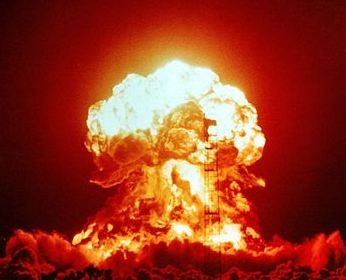Cold Years in Hell: the Aftermath of an India-Pakistan Nuclear War
| Arthur Dominic Villasanta | | Jul 21, 2014 08:36 PM EDT |
A nuclear war between India and Pakistan has always been bandied about as unthinkable. And with good reason.
Even a "limited" exchange of nuclear missiles in support of "theater battlefield operations" is expected to cause immediate and massive human losses on both sides. That human toll and suffering will be made immensely worse by the incredible nuclear damage to the environment in the years after the nuclear blasts.
Like Us on Facebook
India was estimated to have anywhere between 90 to 110 nuclear warheads in early 2013. In that same time, Pakistan's nuclear stockpile was estimated at around 100 to 120 nuclear warheads.
Both countries combined own about 230 warheads of the 17,000 total nuclear warheads in existence worldwide.
The Federation of American Scientists that assesses nuclear weapon stockpiles said the USA has about 7,700 nuclear warheads. Of this total, 1,950 are strategically operational.
Russia owns 8,500 nuclear warheads, of which 1,800 are strategically operational. China has built some 600 nuclear warheads since 1964 but the number operational is very much smaller.
A team of U.S. atmospheric and environmental scientists has studied and modeled what would happen after a limited, regional nuclear war involving India and Pakistan.
The four man team posited their study on a limited war that sees the detonation of 100 nuclear warheads of the same yield that destroyed the Japanese city of Hiroshima in 1945.
The four man U.S. team believes that following an Indian-Pakistani nuclear conflict, five megatons of black carbon from burned substances such as buildings and people are immediately emitted into the atmosphere.
Black carbon is dangerous because it absorbs heat from the sun before this solar radiation can reach the Earth. After a year, the Earth's average surface temperature could drop by 1.1 kelvin (2 degrees Fahrenheit).
Five years after the Indo-Pak nuclear war, the Earth is will be three degrees colder on average than it was before. In this same time period, the Earth will have nine percent less rain than usual. After 26 years, the Earth will receive 4.5 percent less rain than before the war.
The ozone layer that protects the Earth from the worst of the sun's deadly solar radiation and ultraviolet (UV) radiation will take a beating. In the five years after the war, the ozone will become 20 to 25 percent thinner on average.
The lower UV protection leads to more sunburns and skin cancers in people. It also stunts plant growth and destabilizes DNA in crops such as corn.
The International Physicians for the Prevention of Nuclear War in another study believes that two billion people will starve in the aftermath of a nuclear exchange involving 100 nuclear weapons.
©2015 Chinatopix All rights reserved. Do not reproduce without permission
EDITOR'S PICKS
-

Did the Trump administration just announce plans for a trade war with ‘hostile’ China and Russia?
-

US Senate passes Taiwan travel bill slammed by China
-

As Yan Sihong’s family grieves, here are other Chinese students who went missing abroad. Some have never been found
-

Beijing blasts Western critics who ‘smear China’ with the term sharp power
-

China Envoy Seeks to Defuse Tensions With U.S. as a Trade War Brews
-

Singapore's Deputy PM Provides Bitcoin Vote of Confidence Amid China's Blanket Bans
-

China warns investors over risks in overseas virtual currency trading
-

Chinese government most trustworthy: survey
-

Kashima Antlers On Course For Back-To-Back Titles
MOST POPULAR
LATEST NEWS
Zhou Yongkang: China's Former Security Chief Sentenced to Life in Prison

China's former Chief of the Ministry of Public Security, Zhou Yongkang, has been given a life sentence after he was found guilty of abusing his office, bribery and deliberately ... Full Article
TRENDING STORY

China Pork Prices Expected to Stabilize As The Supplies Recover

Elephone P9000 Smartphone is now on Sale on Amazon India

There's a Big Chance Cliffhangers Won't Still Be Resolved When Grey's Anatomy Season 13 Returns

Supreme Court Ruled on Samsung vs Apple Dispute for Patent Infringement

Microsoft Surface Pro 5 Rumors and Release Date: What is the Latest?










